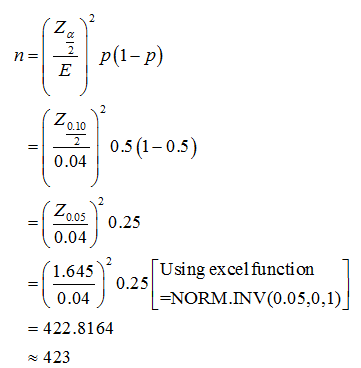In a study of govemment financial aid for college students, it becomes necessary to estimate the percentage of full-time college students who eam a bachelor's degree in four years or less Find the sample size needed to estimate that percentage. Use a 0.04 margin of error and use a confidence level of 90%. Complete parts (a) through (c) below. a Assume that nothing is known about the percentage to be estimated. n-D (Round up to the nearest integer) b. Assume prior studies have shown that about 55% of full-time students eam bachelor's degrees in four years or less. n- (Round up to the nearest integer.) c Does the added knowledge in part (b) have much of an effect on the sample size? OA No, using the additional survey information from part (b) does not change the sample size OB Yos, using the additional survey information from part (b) dramatically reduces the sample size. OC Yes, using the additional survey information from part (b) only slightly increases the sample size. OD. No, using the additional survey information from part (b) only slightly reduces the sample size
In a study of govemment financial aid for college students, it becomes necessary to estimate the percentage of full-time college students who eam a bachelor's degree in four years or less Find the sample size needed to estimate that percentage. Use a 0.04 margin of error and use a confidence level of 90%. Complete parts (a) through (c) below. a Assume that nothing is known about the percentage to be estimated. n-D (Round up to the nearest integer) b. Assume prior studies have shown that about 55% of full-time students eam bachelor's degrees in four years or less. n- (Round up to the nearest integer.) c Does the added knowledge in part (b) have much of an effect on the sample size? OA No, using the additional survey information from part (b) does not change the sample size OB Yos, using the additional survey information from part (b) dramatically reduces the sample size. OC Yes, using the additional survey information from part (b) only slightly increases the sample size. OD. No, using the additional survey information from part (b) only slightly reduces the sample size
MATLAB: An Introduction with Applications
6th Edition
ISBN:9781119256830
Author:Amos Gilat
Publisher:Amos Gilat
Chapter1: Starting With Matlab
Section: Chapter Questions
Problem 1P
Related questions
Topic Video
Question

Transcribed Image Text:In a study of government financial aid for college students, it becomes necessary to estimate the percentage of full-time college students who eam a bachelor's degree in four years or less Find the sample size needed to estimate
that percentage. Use a 0.04 margin of error and use a confidence level of 90%. Complete parts (a) through (c) below.
a. Assume that nothing is known about the percentage to be estimated.
(Round up to the nearest integer.)
b. Assume prior studies have shown that about 55% of full-time students eam bachelor's degrees in four years or less.
(Round up to the nearest integer.)
c. Does the added knowledge in part (b) have much of an effect on the sample size?
OA No, using the additional survey information from part (b) does not change the sample size.
OB. Yes, using the additional survey information from part (b) dramatically reduces the sample size.
OC Yes, using the additional survey information from part (b) only slightly increases the sample size.
OD. No, using the additional survey information from part (b) only slightly reduces the sample size.
Click to select your answer(s)
10:41
DELL
esc
Ce
AV
%23
24
%
&
7\
e
y
u
Expert Solution
Step 1
Solution:
a.
From the given information, confidence level is 0.90 and E=0.04.
Step 2

Since the proportion is not given 0.5 should be taken.
Then,

Thus, n=423.
Trending now
This is a popular solution!
Step by step
Solved in 4 steps with 3 images

Knowledge Booster
Learn more about
Need a deep-dive on the concept behind this application? Look no further. Learn more about this topic, statistics and related others by exploring similar questions and additional content below.Recommended textbooks for you

MATLAB: An Introduction with Applications
Statistics
ISBN:
9781119256830
Author:
Amos Gilat
Publisher:
John Wiley & Sons Inc

Probability and Statistics for Engineering and th…
Statistics
ISBN:
9781305251809
Author:
Jay L. Devore
Publisher:
Cengage Learning

Statistics for The Behavioral Sciences (MindTap C…
Statistics
ISBN:
9781305504912
Author:
Frederick J Gravetter, Larry B. Wallnau
Publisher:
Cengage Learning

MATLAB: An Introduction with Applications
Statistics
ISBN:
9781119256830
Author:
Amos Gilat
Publisher:
John Wiley & Sons Inc

Probability and Statistics for Engineering and th…
Statistics
ISBN:
9781305251809
Author:
Jay L. Devore
Publisher:
Cengage Learning

Statistics for The Behavioral Sciences (MindTap C…
Statistics
ISBN:
9781305504912
Author:
Frederick J Gravetter, Larry B. Wallnau
Publisher:
Cengage Learning

Elementary Statistics: Picturing the World (7th E…
Statistics
ISBN:
9780134683416
Author:
Ron Larson, Betsy Farber
Publisher:
PEARSON

The Basic Practice of Statistics
Statistics
ISBN:
9781319042578
Author:
David S. Moore, William I. Notz, Michael A. Fligner
Publisher:
W. H. Freeman

Introduction to the Practice of Statistics
Statistics
ISBN:
9781319013387
Author:
David S. Moore, George P. McCabe, Bruce A. Craig
Publisher:
W. H. Freeman